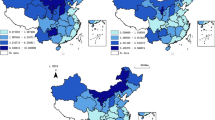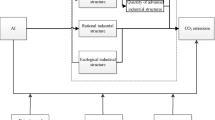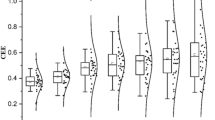Abstract
How to achieve the goal of "carbon peak and carbon neutrality" and explore the compatibility of industrial and ecological civilization is a major challenge for China today. This study analyzes the impact of industrial intelligence on industrial carbon emissions efficiency in 11 provinces of China’s Yangtze River Economic Belt, measuring the efficiency of industrial carbon emissions through the non-expected output slacks-based measure (SBM) model, selecting industrial robot penetration to measure the level of industrial intelligence, establishing a two-way fixed model to verify the impact of industrial intelligence on carbon emission efficiency, and testing for intermediary effects and regional heterogeneity. The results show that: (1) the industrial carbon emission efficiency of the 11 provinces shows year-over-year improvement, with significant differences between upstream, midstream, and downstream, where downstream is the highest and upstream is the lowest. (2) The development of industrial intelligence is highly uneven, with the upstream level being the weakest. (3) Industrial intelligence can improve the efficiency of industrial carbon emissions by enhancing green technological innovation and energy use efficiency. (4) The effect of industrial intelligence on industrial carbon emission efficiency also shows regional heterogeneity. Finally, we present policy recommendations. This research provides mathematical and scientific support for achieving carbon reduction targets at an early stage and helps accelerate the construction of a modern, low-carbon China.


Similar content being viewed by others
Data availability
Not applicable.
Notes
The "provinces" mentioned in the study include two centrally administered municipalities (Shanghai, and Chongqing).
References
Acemoglu D, Restrepo P (2019) Automation and new tasks: How technology displaces and reinstates labor. J Econ Perspect 33(2):3–30
Acemoglu D, Restrepo P (2020) Robots and jobs: Evidence from US labor markets. J Polit Econ 128(6):2188–2244
Aldy JE (2006) Per capita carbon dioxide emissions: convergence or divergence? Environ Resource Econ 33(4):533–555
Bai D, Dong Q, Khan SAR, Chen Y, Wang D, Yang L (2022) Spatial analysis of logistics ecological efficiency and its influencing factors in China: based on super-SBM-undesirable and spatial Dubin models. Environ Sci Pollut Res 29(7):10138–10156
Charnes A, Cooper WW, Rhodes E (1978) Measuring the efficiency of decision making units. Eur J Oper Res 2(6):429–444
Chen Y, Miao J, Zhu Z (2021) Measuring green total factor productivity of China’s agricultural sector: a three-stage SBM-DEA model with non-point source pollution and CO2 emissions. J Clean Prod 318:128543
Chen Y, Cheng L, Lee CC (2022) How does the use of industrial robots affect the ecological footprint? International evidence. Ecol Econ 198:107483
Cheng Z, Li L, Liu J, Zhang H (2018) Total-factor carbon emission efficiency of China’s provincial industrial sector and its dynamic evolution. Renew Sustain Energy Rev 94:330–339
Du K, Li P, Yan Z (2019) Do green technology innovations contribute to carbon dioxide emission reduction? Empirical evidence from patent data. Technol Forecast Soc Chang 146:297–303
Färe R, Grosskopf S (2004) Modeling undesirable factors in efficiency evaluation: Comment. Eur J Oper Res 157(1):242–245
Farrell MJ (1957) The measurement of productive efficiency. J R Stat Soc: Series A (general) 120(3):253–281
Graetz G, Michaels G (2018) Robots at work. Rev Econ Stat 100(5):753–768
Han MC, Han QJ, Xia L (2020) The lmpact of lndustrial Robot Application on Manufacturing Employment: An Empirical Study: Based on the Data of Prefecture Level Cities in China. Reform 03:22–39
Huang B, Wu B, Barry M (2010) Geographically and temporally weighted regression for modeling spatio-temporal variation in house prices. Int J Geogr Inf Sci 24(3):383–401
Huang HY, Liu Y, Peng G (2021) Impact of Industrial Intelligentization on Carbon Emissions —An Empirical Study on China’s Subdivided Industries. Stat Decis 37(17):80–84
Jiang X, Ma J, Zhu H, Guo X, Huang Z (2020) Evaluating the carbon emissions efficiency of the logistics industry based on a Super-SBM Model and the Malmquist Index from a strong transportation strategy perspective in China. Int J Environ Res Public Health 17(22):8459
Jiang H, Yin J, Qiu Y, Zhang B, Ding Y, Xia R (2022) Industrial carbon emission efficiency of cities in the pearl river basin: Spatiotemporal dynamics and driving forces. Land 11(8):1129
Jin T, Kim J (2019) A comparative study of energy and carbon efficiency for emerging countries using panel stochastic frontier analysis. Sci Rep 9(1):1–8
Kaya Y, Yokobori K (eds) (1997) Environment, energy, and economy: strategies for sustainability. United Nations University Press, Tokyo, pp 16–26
Korinek A, Stiglitz JE (2021) Artificial intelligence, globalization, and strategies for economic development (No. w28453). National Bureau of Economic Research
Le TL, Lee PP, Peng KC, Chung RH (2019) Evaluation of total factor productivity and environmental efficiency of agriculture in nine East Asian countries. Agric Econ 65(6):249–258
Lee CC, Qin S, Li Y (2022a) Does industrial robot application promote green technology innovation in the manufacturing industry? Technol Forecast Soc Chang 183:121893
Lee CC, Chang YF, Wang EZ (2022b) Crossing the rivers by feeling the stones: The effect of China’s green credit policy on manufacturing firms’ carbon emission intensity. Energy Econ 116:106413
Lee CC, Wang F, Lou R, Wang K (2023) How does green finance drive the decarbonization of the economy? Empirical evidence from China. Renew Energy
Li T, Fu Q (2011) Study on China’s carbon dioxide emissions efficiency. Stat Res 7:62–71
Li J, Ma XF, Yuan QM (2019) Evaluation and influencing factors’ analysis of regional carbon emission efficiency. J Environ Sci 39(12):4293–4300
Li Y, Zhang Y, Pan A, Han M, Veglianti E (2022) Carbon emission reduction effects of industrial robot applications: Heterogeneity characteristics and influencing mechanisms. Technol Soc 70:102034
Lin B, Long H (2015) A stochastic frontier analysis of energy efficiency of China’s chemical industry. J Clean Prod 87:235–244
Liu J, Chang H, Forrest JYL, Yang B (2020a) Influence of artificial intelligence on technological innovation: Evidence from the panel data of china’s manufacturing sectors. Technol Forecast Soc Chang 158:120142
Liu Y, Zhu J, Li EY, Meng Z, Song Y (2020b) Environmental regulation, green technological innovation, and eco-efficiency: the case of yangtze river economic belt in china. Technol Forecast Soc Chang 155:119993
Liu J, Liu L, Qian Y, Song S (2022a) The effect of artificial intelligence on carbon intensity: Evidence from China’s industrial sector. Socioecon Plann Sci 83:101002
Liu J, Qian Y, Cao YR, Li LS (2022b) Driving factors and regional differences of intelligent Manufacturing in China. China Sci Technol Forum 1:84–93
Liu L, Li M, Gong X, Jiang P, Jin R, Zhang Y (2022c) Influence Mechanism of Different Environmental Regulations on Carbon Emission Efficiency. Int J Environ Res Public Health 19(20):13385
Liu B, De Giovanni P (2019) Green process innovation through Industry 4.0 technologies and supply chain coordination. Ann Oper Res 1–36
Mielnik O, Goldemberg J (1999) Communication The evolution of the “carbonization index” in developing countries. Energy Policy 27(5):307–308
Ramanathan R (2002) Combining indicators of energy consumption and CO2 emissions: a cross-country comparison. Int J Global Energy Issues 17(3):214–227
Ramanathan R (2006) A multi-factor efficiency perspective to the relationships among world GDP, energy consumption and carbon dioxide emissions. Technol Forecast Soc Chang 73(5):483–494
Ren FR, Tian Z, Chen HS, Shen YT (2021) Energy consumption, CO2 emissions, and agricultural disaster efficiency evaluation of China based on the two-stage dynamic DEA method. Environ Sci Pollut Res 28(2):1901–1918
Song XG, Zuo MH (2019) Industrial Robot Input, Labor Supply and Labor Productivity. Reform 09:45–54
Sun Z, Hou YL (2019) How does industrial intelligence reshape the employment structure of chinese labor force. China Ind Econ 05:61–79
Tang XH, Chi ZM (2022a) An Empirical Study on Industrial Intelligence to lmprove the ETficiency or inaustrla oreen Development. Economist 02:43–52
Tang XH, Chi ZM (2022b) The lmpact of lndustrial lntelligence on the High-Quality Development of Manufacturinglndustry. Contemp Financ Econ 5:102–114
Teng X, Liu FP, Chiu YH (2021) The change in energy and carbon emissions efficiency after afforestation in China by applying a modified dynamic SBM model. Energy 216:119301
Tone K (2001) A slacks-based measure of efficiency in data envelopment analysis. Eur J Oper Res 130(3):498–509
Wang B, Wu Y, Yan P (2010) Environmental efficiency and environmental total factor productivity growth in China’s regional economies. Econ Res J 45(5):95–109
Wang J, Qiu D, Jiang Q, Zhang M (2019) Research on measurement and promotion path of industrial green development efficiency in Yangtze river economic belt. Sci Technol Manag Res 39(12):46–52
Wang EZ, Lee CC, Li Y (2022) Assessing the impact of industrial robots on manufacturing energy intensity in 38 countries. Energy Econ 105:105748
Wang C, Wang XJ (2022) Carbon emission efficiency in the Yangtze River Economic Belt: Measurement and analysis 17:016
Wen ZL, Ye BJ (2014) Analyses of mediating effects: the development of methods and models. Adv Psychologicalence 22(5):731–745
Xue F, Liu JQ, Fu YM (2022) The impact of artificial intelligence technology on carbon emission. Sci Technol Prog Countermeasures
Yan XL, Zhu BK, Ma C (2020) Employment under Robot lmpact: Evidence from China Manufacturing. Stat Res 1:74–87
Yao X, Guo C, Shao S, Jiang Z (2016) Total-factor CO2 emission performance of China’s provincial industrial sector: A meta-frontier non-radial Malmquist index approach. Appl Energy 184:1142–1153
Zafar SZ, Zhilin Q, Malik H, Abu-Rumman A, Al Shraah A, Al-Madi F, Alfalah TF (2021) Spatial spillover effects of technological innovation on total factor energy efficiency: taking government environment regulations into account for three continents. Bus Process Manag J 27(6):1874–1891
Zaim O, Taskin F (2000) Environmental efficiency in carbon dioxide emissions in the OECD: A non-parametric approach. J Environ Manag 58(2):95–107
Zhang Y, Xu X (2022) Carbon emission efficiency measurement and influencing factor analysis of nine provinces in the Yellow River basin: Based on SBM-DDF model and Tobit-CCD model. Environ Sci Pollut Res 29(22):33263–33280
Zhang SL, Yu HS (2015) Spatial econometric analysis of the efficiency of industrial carbon emissions and its influencing factors. Sci Technol Econ 04:106–110
Zhang X, Li GQ (2022) lndustrial intelligence and the degree of urban global value chain embedding. Studies in Science of Science 09:1598–1607. https://doi.org/10.16192/j.cnki.1003-2053.20220302.009
Zhou W, Nie M (2012) Regional differences in the efficiency of industrial carbon emissions in China. J Quant Tech Econ 09:58–70
Zhou Y, Liu W, Lv X, Chen X, Shen M (2019) Investigating interior driving factors and cross-industrial linkages of carbon emission efficiency in China’s construction industry: Based on Super-SBM DEA and GVAR model. J Clean Prod 241:118322
Zofıo JL, Prieto AM (2001) Environmental efficiency and regulatory standards: the case of CO2 emissions from OECD industries. Resour Energy Econ 23(1):63–83
Acknowledgements
This study was supported by the National Planning Office of Philosophy and Social Science (CN) (No. 19CTJ005). We would like to extend our special thanks to the editor and anonymous reviewers for their constructive comments and suggestions to improve the quality of this study.
Funding
This study was supported by the National Planning Office of Philosophy and Social Science (CN) (No. 19CTJ005).
Author information
Authors and Affiliations
Contributions
Qiu Huang:Conceptualization, Methodology, Writing- Original draft preparation.
Qiaoqi Chen:Model construction.
Xiaochun Qin: Formal analysis.
Xinlei Zhang: Data Curation, Review.
Corresponding author
Ethics declarations
Ethics approval and consent to participate
Not applicable.
Consent for publication
Not applicable.
Competing interests
The authors declare no competing interests.
Additional information
Responsible Editor: V.V.S.S. Sarma
Publisher's note
Springer Nature remains neutral with regard to jurisdictional claims in published maps and institutional affiliations.
Rights and permissions
Springer Nature or its licensor (e.g. a society or other partner) holds exclusive rights to this article under a publishing agreement with the author(s) or other rightsholder(s); author self-archiving of the accepted manuscript version of this article is solely governed by the terms of such publishing agreement and applicable law.
About this article
Cite this article
Huang, Q., Chen, Q., Qin, X. et al. Study on the influence of industrial intelligence on carbon emission efficiency–empirical analysis of China’s Yangtze River Economic Belt. Environ Sci Pollut Res 30, 82248–82263 (2023). https://doi.org/10.1007/s11356-023-28160-1
Received:
Accepted:
Published:
Issue Date:
DOI: https://doi.org/10.1007/s11356-023-28160-1




